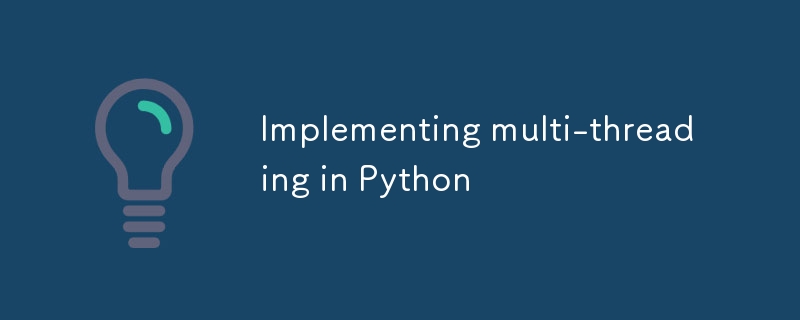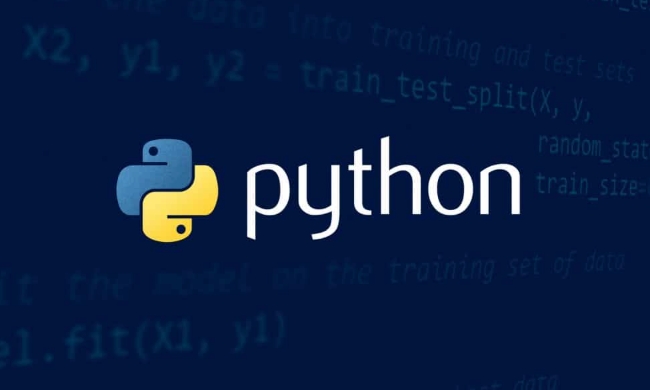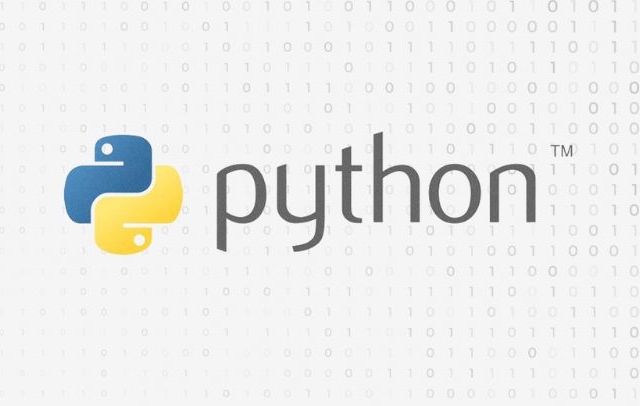Python multithreading is suitable for I/O-intensive tasks. 1. It is suitable for scenarios such as network requests, file reading and writing, user input waiting, etc., such as multi-threaded crawlers can save request waiting time; 2. It is not suitable for computing-intensive tasks such as image processing and mathematical operations, and cannot operate in parallel due to global interpreter lock (GIL). Implementation method: You can create and start threads through the threading module, and use join() to ensure that the main thread waits for the child thread to complete, and use Lock to avoid data conflicts, but it is not recommended to enable too many threads to avoid affecting performance. In addition, the ThreadPoolExecutor of the concurrent.futures module provides a simpler usage, supports automatic management of thread pools, asynchronous results acquisition, and map-based functions. Common problems include misunderstanding the role of GIL, unlocked shared variables, forgetting the join and too many threads lead to resource competition, which needs to be checked through logs or debugging tools.

Python's multi-threading implementation is actually a bit special. Many people initially thought it could make full use of multi-core CPUs like other languages, but in fact, it was not ideal. The main reason is that Python has a global interpreter lock (GIL), which restricts only one thread to execute Python bytecode at the same time. However, this does not mean that multithreading is useless in Python, there are still many scenarios that can be used.

What scenarios is multithreading suitable for?
Python's threading module is suitable for I/O-intensive tasks , such as network requests, file reading and writing, waiting for user input, etc. This kind of task is waiting for external resources most of the time. At this time, the switching thread will not be affected by GIL, but can improve overall efficiency.
For example: If you want to crawl data from multiple websites and each request has to wait for a few seconds to respond, then opening several threads to send requests at the same time can save a lot of time.

- Web crawler
- Log collection and processing
- Prevent interface stuttering in GUI applications
It is not recommended for calculation-intensive tasks (such as image processing, large amounts of math operations), because these tasks will be stuck with GIL and cannot be truly parallel.
How to use threading to implement multi-threading?
Using threading is the most straightforward way. The basic process is to create a thread object, specify the objective function, and then start the thread.

import threading
def worker():
print("Worker is running")
threads = []
for i in range(5):
t = threading.Thread(target=worker)
threads.append(t)
t.start()A few points to note:
- If you want all child threads such as the main thread to complete, you can add
t.join() - When sharing data, use locks (
threading.Lock()) to avoid conflicts. - It is not recommended to open too many threads, as dozens of them are almost the same, too many will slow down performance.
Is there a simpler way to write it? Try concurrent.futures
If you don't want to manually manage thread lifecycles, consider ThreadPoolExecutor in the concurrent.futures module, which is more concise and easier to control the number of concurrency.
from concurrent.futures import ThreadPoolExecutor
def fetch_url(url):
# Simulate a network request return f"Response from {url}"
urls = ["https://example.com/1", "https://example.com/2"]
with ThreadPoolExecutor(max_workers=5) as executor:
results = list(executor.map(fetch_url, urls))This method has several advantages:
- Automatically manage thread pool size
- Supports asynchronous results (via Future objects)
- It is easier to use with map, as_completed functions and other functions
Multi-threading pit
Although it is simple to use, there are some places that are prone to problems, especially for beginners.
- GIL's misunderstanding : I thought that I could run the CPU by opening multiple threads, but in fact, it was not very helpful to CPU-intensive tasks.
- Shared variables are not locked : multiple threads modify a variable at the same time may cause data confusion.
- Forgot join : The main thread ends too fast and the child thread is killed before it has been executed.
- Too many threads : Excessive concurrency can lead to resource competition and context switching overhead.
When encountering these problems, you might as well print the log first to see the thread execution order, or use debugging tools to observe the thread status.
Basically that's it. Python's multi-threading is not omnipotent, but it is still very practical in suitable scenarios. Mastering its scope of application and usage can make your program handle some tasks more efficiently.
The above is the detailed content of Implementing multi-threading in Python. For more information, please follow other related articles on the PHP Chinese website!

Hot AI Tools

Undress AI Tool
Undress images for free

Undresser.AI Undress
AI-powered app for creating realistic nude photos

AI Clothes Remover
Online AI tool for removing clothes from photos.

Clothoff.io
AI clothes remover

Video Face Swap
Swap faces in any video effortlessly with our completely free AI face swap tool!

Hot Article

Hot Tools

Notepad++7.3.1
Easy-to-use and free code editor

SublimeText3 Chinese version
Chinese version, very easy to use

Zend Studio 13.0.1
Powerful PHP integrated development environment

Dreamweaver CS6
Visual web development tools

SublimeText3 Mac version
God-level code editing software (SublimeText3)
 PHP calls AI intelligent voice assistant PHP voice interaction system construction
Jul 25, 2025 pm 08:45 PM
PHP calls AI intelligent voice assistant PHP voice interaction system construction
Jul 25, 2025 pm 08:45 PM
User voice input is captured and sent to the PHP backend through the MediaRecorder API of the front-end JavaScript; 2. PHP saves the audio as a temporary file and calls STTAPI (such as Google or Baidu voice recognition) to convert it into text; 3. PHP sends the text to an AI service (such as OpenAIGPT) to obtain intelligent reply; 4. PHP then calls TTSAPI (such as Baidu or Google voice synthesis) to convert the reply to a voice file; 5. PHP streams the voice file back to the front-end to play, completing interaction. The entire process is dominated by PHP to ensure seamless connection between all links.
 How to use PHP combined with AI to achieve text error correction PHP syntax detection and optimization
Jul 25, 2025 pm 08:57 PM
How to use PHP combined with AI to achieve text error correction PHP syntax detection and optimization
Jul 25, 2025 pm 08:57 PM
To realize text error correction and syntax optimization with AI, you need to follow the following steps: 1. Select a suitable AI model or API, such as Baidu, Tencent API or open source NLP library; 2. Call the API through PHP's curl or Guzzle and process the return results; 3. Display error correction information in the application and allow users to choose whether to adopt it; 4. Use php-l and PHP_CodeSniffer for syntax detection and code optimization; 5. Continuously collect feedback and update the model or rules to improve the effect. When choosing AIAPI, focus on evaluating accuracy, response speed, price and support for PHP. Code optimization should follow PSR specifications, use cache reasonably, avoid circular queries, review code regularly, and use X
 python seaborn jointplot example
Jul 26, 2025 am 08:11 AM
python seaborn jointplot example
Jul 26, 2025 am 08:11 AM
Use Seaborn's jointplot to quickly visualize the relationship and distribution between two variables; 2. The basic scatter plot is implemented by sns.jointplot(data=tips,x="total_bill",y="tip",kind="scatter"), the center is a scatter plot, and the histogram is displayed on the upper and lower and right sides; 3. Add regression lines and density information to a kind="reg", and combine marginal_kws to set the edge plot style; 4. When the data volume is large, it is recommended to use "hex"
 PHP integrated AI emotional computing technology PHP user feedback intelligent analysis
Jul 25, 2025 pm 06:54 PM
PHP integrated AI emotional computing technology PHP user feedback intelligent analysis
Jul 25, 2025 pm 06:54 PM
To integrate AI sentiment computing technology into PHP applications, the core is to use cloud services AIAPI (such as Google, AWS, and Azure) for sentiment analysis, send text through HTTP requests and parse returned JSON results, and store emotional data into the database, thereby realizing automated processing and data insights of user feedback. The specific steps include: 1. Select a suitable AI sentiment analysis API, considering accuracy, cost, language support and integration complexity; 2. Use Guzzle or curl to send requests, store sentiment scores, labels, and intensity information; 3. Build a visual dashboard to support priority sorting, trend analysis, product iteration direction and user segmentation; 4. Respond to technical challenges, such as API call restrictions and numbers
 python list to string conversion example
Jul 26, 2025 am 08:00 AM
python list to string conversion example
Jul 26, 2025 am 08:00 AM
String lists can be merged with join() method, such as ''.join(words) to get "HelloworldfromPython"; 2. Number lists must be converted to strings with map(str, numbers) or [str(x)forxinnumbers] before joining; 3. Any type list can be directly converted to strings with brackets and quotes, suitable for debugging; 4. Custom formats can be implemented by generator expressions combined with join(), such as '|'.join(f"[{item}]"foriteminitems) output"[a]|[
 python pandas melt example
Jul 27, 2025 am 02:48 AM
python pandas melt example
Jul 27, 2025 am 02:48 AM
pandas.melt() is used to convert wide format data into long format. The answer is to define new column names by specifying id_vars retain the identification column, value_vars select the column to be melted, var_name and value_name, 1.id_vars='Name' means that the Name column remains unchanged, 2.value_vars=['Math','English','Science'] specifies the column to be melted, 3.var_name='Subject' sets the new column name of the original column name, 4.value_name='Score' sets the new column name of the original value, and finally generates three columns including Name, Subject and Score.
 Optimizing Python for Memory-Bound Operations
Jul 28, 2025 am 03:22 AM
Optimizing Python for Memory-Bound Operations
Jul 28, 2025 am 03:22 AM
Pythoncanbeoptimizedformemory-boundoperationsbyreducingoverheadthroughgenerators,efficientdatastructures,andmanagingobjectlifetimes.First,usegeneratorsinsteadofliststoprocesslargedatasetsoneitematatime,avoidingloadingeverythingintomemory.Second,choos
 python connect to sql server pyodbc example
Jul 30, 2025 am 02:53 AM
python connect to sql server pyodbc example
Jul 30, 2025 am 02:53 AM
Install pyodbc: Use the pipinstallpyodbc command to install the library; 2. Connect SQLServer: Use the connection string containing DRIVER, SERVER, DATABASE, UID/PWD or Trusted_Connection through the pyodbc.connect() method, and support SQL authentication or Windows authentication respectively; 3. Check the installed driver: Run pyodbc.drivers() and filter the driver name containing 'SQLServer' to ensure that the correct driver name is used such as 'ODBCDriver17 for SQLServer'; 4. Key parameters of the connection string






